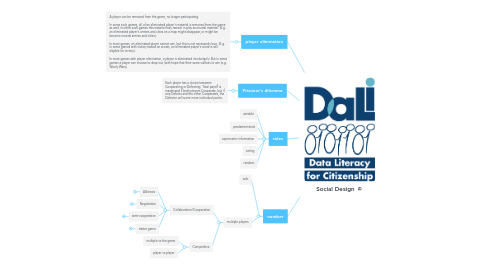
1. player elimination
1.1. A player can be removed from the game, no longer participating. In some such games, all of an eliminated player's material is removed from the game as well; in other such games this material may remain in play as neutral material. (E.g. an eliminated player's armies and cities on a map might disappear, or might be become neutral armies and cities.) In most games, an eliminated player cannot win, but this is not necessarily true. (E.g. in some games with victory based on scores, an eliminated player's score is still eligible for victory.) In most games with player elimination, a player is eliminated involuntarily. But in some games a player can choose to drop out (with hope that their score suffices to win (e.g. Wooly Wars).
2. Prisoner's dilemma
2.1. Each player has a choice between Cooperating or Defecting. Total payoff is maximized if both players Cooperate, but if one Defects and the other Cooperates, the Defector will score more individual points.
3. roles
3.1. variable
3.2. predertermined
3.3. asymmetric information
3.4. voting
3.5. random
4. number
4.1. solo
4.2. multiple players
4.2.1. Collaboration/Cooperation
4.2.1.1. Alliances
4.2.1.1.1. Players have formal relationships that may change over the course of the game. This differs from Negotiation in that these relationships are governed by specific game rules. For example, in Dune, players may form alliances at each Nexus phase, which last until the next Nexus. During that time the players win together, may not attack each other, and grant their ally a special power. In Struggle of Empires players bid for the right to select their ally for that round, which is governed by similar rules.
4.2.1.2. Negotiation
4.2.1.2.1. Players make agreements about coordinating action, beyond simply Trading. Agreements may be either binding or non-binding. Diplomacy is a notable example of the latter.
4.2.1.3. semi-cooperative
4.2.1.3.1. A game in which players are cooperating and competing with each other throughout the game, while trying to complete a common objective. To be classified as semi-cooperative, there must be two possible end states: A) One or more (but unlikely to be all) players win B) No players win A game where players sometimes cooperate and sometimes compete but one always wins is not semi-cooperative. It is a Competitive game with a Negotiation mechanism.
4.2.1.4. traitor game
4.2.1.4.1. A traitor game can be seen as a kind of team game, or as a cooperative game with a betrayal mechanism. The traitors typically win by triggering a failure condition for the players. For this mechanism, a traitor game is characterized by traitors that begin the game with hidden identities, or are assigned them during the game.
4.2.2. Competitive
4.2.2.1. multiple vs the game
4.2.2.2. player vs player
